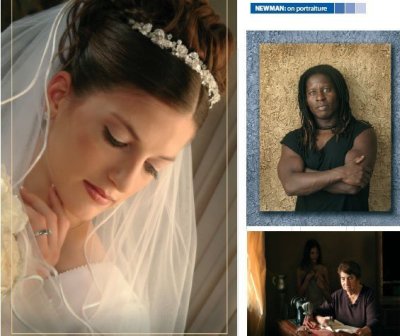articles/Portraiture/physiognomy-page2
Physiognomy PORTRAITURE and the Study of the Human Face - part 2 of 1 2 3
by Dave Newman Published 01/02/2005

A LENS FOR THE TASK
Lens choice, for traditional head-and-shoulder portraiture can be derived by calculating twice the diagonal length of the film or CCD, and converting it into a lens length. A common example is: a 6x7cm negative that has a diagonal measurement of 9cm.Two times this measurement is18cm. This figure yields a request for a 180mm telephoto lens as a result of relating the measurement of the film plane to the focal length. Another typical example is the 35mm negative with a diagonal measurement of 43mm that results in the use of (approximately) a 90mm lens for distortion-free head-and shoulder portraiture. This simple formula provides a comfortable working distance, for conversation and assessment yet provides enough optical distance to eliminate distortion. The rule of thumb is to remember that a longer lens provides an undistorted, cleaner facial rendering, while a shorter lens can give only the sad, distorted opposite.
A SUITABLE LIGHTING PATTERN
A through study of studio lighting patterns and ratios would involve an entire book rather than the summary paragraph presented here. As a general rule, I adhere to simple guidelines. Lighting ratio is more productive if kept between 3:1 or 4:1 for general portraiture, and 5:1 (when applying diffusion). Lighting ratios can set the feeling and tone of the session, as well as the limited printing-control factors, and must be applied with knowledge and taste. Generally speaking, most subjects can be handled best (to my liking) by using a short-lighting pattern. By short-lighting, I mean shooting into the shadow side of the face. Short lighting most often yields a flattering portrayal of the human face since it slims, and can be used to deemphasize larger ears or unbalanced facial features that are placed into the shadow side of the face. Believe it or not, thin faces also can be widened with short lighting by simply swinging the key light's arc closer in toward the camera; round faces are slimmed by the opposite treatment of moving the key light's arc away from the camera position. The height of the key light is dictated by the depth of the eyes and the facial structure. I'm paying little attention to the nose shadow in relation to the lips, but rather to the "good" feeling of the portrayal of the eyes. The eyes, as we know, can be the window to the soul of the sitter if treated properly. I personally almost never find much corrective control in using broad lighting. The butterfly type Covergirl / glamour lighting is another story and should be used only if the face is well balanced and the makeup has already built-up the necessary contouring and modelling.
CORRECTIVE POSING
Another control besides proper lens length and flattering facial lighting is definitely the facial angle as it relates to the viewer / camera. We must remember that we are reducing a three-dimensional subject to the two-dimensions of a flat piece of photographic paper. The third, or depth, factor in the three dimensions of our client which is lost in a photographic process can be reintroduced by the skilled application of lighting and shadow upon the subject's face if the angle of the face is considered first and used as the starting point. Begin with the camera directed into the bridge of the nose (this can be raised or lowered in relation to the desired facial effect, i.e., raising to reduce a large chin, or lowering to reduce a prominent forehead. Careful adherence to one of the five basic views of the human face keeps me out of trouble.The five classic views of the face are: full front, two-thirds (left and right), and profile (left and right). Avoid the split profile of the face (which allows the nose to break or cross the cheek line) in order to render the face without undue awkwardness or distortion.
A detailed awareness of these corrective methods for the "simple" head-and-shoulder pose can help fulfill the client's request for a more flattering rendition of his or her face. This list appears here in summation, as an over-simplification. The list of corrections and remedies could, indeed, go on and on.
Please Note:
There is more than one page for this Article.
You are currently on page 2
- Physiognomy PORTRAITURE and the Study of the Human Face page 1
- Physiognomy PORTRAITURE and the Study of the Human Face page 2
- Physiognomy PORTRAITURE and the Study of the Human Face page 3
1st Published 01/02/2005
last update 09/12/2022 14:57:55
More Portraiture Articles
There are 0 days to get ready for The Society of Photographers Convention and Trade Show at The Novotel London West, Hammersmith ...
which starts on Wednesday 15th January 2025





